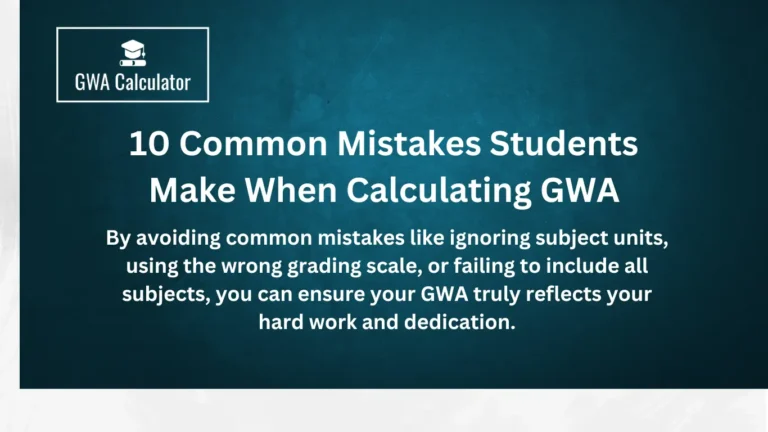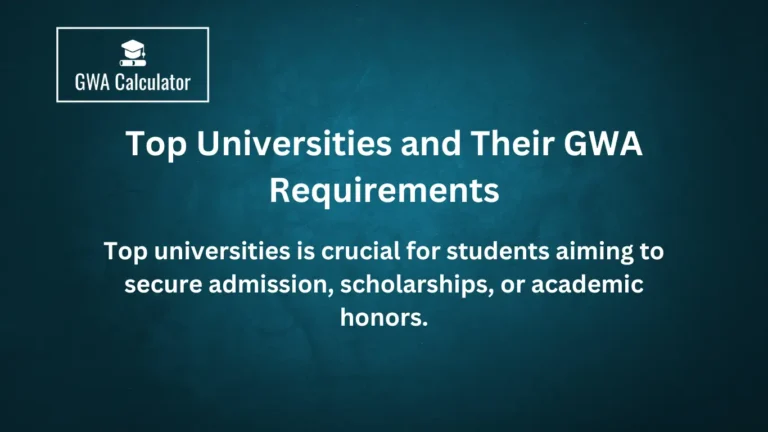What is GWA? A Comprehensive Guide for Students in the Philippines
In the Philippine education system, one of the most important metrics used to gauge academic performance is the General Weighted Average (GWA). Whether you’re a high school, college, or university student, understanding GWA can help you monitor your academic standing and plan for the future.
In this comprehensive guide, we will explore what GWA is, how it is computed, and how it differs from other grading metrics like GPA. We will also provide insights on how students, parents, and academic advisors can use GWA to track performance.
This article is written to help you understand everything you need to know about GWA in the Philippines and includes tools like a GWA to GPA Converter and GWA to Percentage Calculator to assist in your academic journey.
What is GWA?
GWA stands for General Weighted Average, a grading system used by most schools, colleges, and universities in the Philippines. It is an aggregate measure that takes into account the grades students receive in their subjects, weighted by the number of credits or units each subject carries.
GWA is crucial because it reflects a student’s overall academic performance across all subjects, offering a single value that represents their achievements over a given period, typically a semester or academic year.
How Does GWA Differ from GPA?
While GWA and GPA (Grade Point Average) are similar, they are not exactly the same. The GPA system, widely used in Western countries, calculates grades based on a 4.0 scale, with 4.0 being the highest possible grade. On the other hand, the GWA system typically uses a different grading scale (depending on the institution), such as a 1.0 (highest) to 5.0 (lowest) scale, with 1.0 representing the best performance.
In the Philippines, converting GWA to GPA may be necessary for students applying to universities abroad or in local institutions that adopt a GPA system.
Read More: PUP Grading System: A Guide for Students in the Philippines
How to Compute GWA?
Calculating your GWA is relatively simple once you understand how it works. Here is the basic formula for computing your General Weighted Average (GWA):
GWA = (Grade1 × Credit1 + Grade2 × Credit2 + … + GradeN × CreditN) / (Credit1 + Credit2 + … + CreditN)Step-by-Step Process to Compute GWA:
- List All Your Subjects – Start by gathering the grades for all your subjects for a given semester or school year.
- Identify the Credit Units – Each subject has a specific number of credit units. Typically, major subjects have higher credits than minor ones.
- Multiply Grades by Credit Units – For each subject, multiply the grade you received by the number of credit units it holds.
- Add the Products – Sum up the results of all the products from step 3.
- Divide by Total Credit Units – Finally, divide the sum by the total number of credit units you’ve taken during the semester or academic year.
Here’s an example of GWA computation:
| Subject | Grade | Credits |
|---|---|---|
| Mathematics | 1.5 | 3 |
| English | 2.0 | 3 |
| Science | 1.75 | 4 |
| History | 2.25 | 2 |
| PE | 1.25 | 1 |
GWA = (1.5 × 3 + 2.0 × 3 + 1.75 × 4 + 2.25 × 2 + 1.25 × 1) / (3 + 3 + 4 + 2 + 1)
= (4.5 + 6 + 7 + 4.5 + 1.25) / 13
= 23.25 / 13
= 1.79
In this example, the student’s General Weighted Average (GWA) is 1.79.
GWA to GPA Converter
If you are aiming to convert your GWA to GPA for university applications or other purposes, you can use a simple conversion table. Different institutions have varying conversion standards, so it’s important to confirm with your school or target institution. However, a general approximation is:
| GWA Range | GPA Equivalent (4.0 Scale) |
|---|---|
| 1.0 – 1.5 | 4.0 |
| 1.51 – 1.75 | 3.5 |
| 1.76 – 2.0 | 3.0 |
| 2.01 – 2.25 | 2.5 |
| 2.26 – 2.5 | 2.0 |
| 2.51 – 2.75 | 1.5 |
| 2.76 – 3.0 | 1.0 |
This approximation may vary, but it gives you a good idea of how to convert your grades from GWA to GPA.
GWA to Percentage Calculator
Sometimes students need to convert their GWA into a percentage for various purposes, such as scholarship applications or international studies. Although there is no exact formula for GWA to percentage conversion since each school may have its own scale, a general rule is to multiply your GWA by 20 to get an estimated percentage score.
For example:
- GWA = 1.79
- Percentage = 1.79 × 20 = 35.8%
This may seem low, but remember that in the Philippine system, a 1.0 is the highest possible grade, which represents academic excellence. If your school uses a different conversion method, it’s always best to consult them directly.
Read More: The DepEd Grading System: A Comprehensive Guide for Students and Educators in the Philippines
Why is GWA Important?
The General Weighted Average is a critical factor in determining a student’s academic standing. Many universities and colleges in the Philippines use GWA as a requirement for honors, scholarships, or even for retention in certain programs.
Honors and Awards
In most academic institutions in the Philippines, a high GWA can qualify a student for honors or Latin honors, such as:
- Cum Laude (GWA of 1.75 or better)
- Magna Cum Laude (GWA of 1.50 or better)
- Summa Cum Laude (GWA of 1.25 or better)
This system encourages students to maintain a consistently high level of performance across all subjects, as the GWA reflects their overall academic capabilities.
Read More: The College Grading System in the Philippines: A Comprehensive Guide
Conclusion
Understanding what GWA is and how to calculate it is vital for students in the Philippines, particularly those who want to excel academically. Whether you’re looking to calculate your GWA for personal tracking, convert it to GPA for international applications, or simply understand how it affects your academic future, this guide provides you with the necessary tools and knowledge.
With resources like the GWA to GPA Converter and GWA to Percentage Calculator, students, parents, and academic advisors can better interpret academic performance and work towards improving overall academic success. Mastering your GWA not only helps in achieving honors but also opens up more academic opportunities in the Philippines and abroad.







